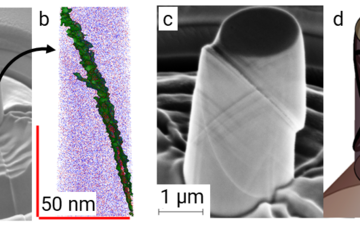All genres
1201.
Talk
The Role of Chromium and Cobalt Segregation at Dislocations on the γ Dissolution in Nickel Based Superalloys. 18th International Conference on the Strength of Materials (ICSMA 18), Ohio State University, Columbus, OH, USA (2018)
1202.
Talk
Interstitially alloyed high-entropy alloys with improved mechanical properties. Thermec 2018, Paris, France (2018)
1203.
Talk
Hydrogen enhances strength and ductility of an equiatomic high-entropy alloy. Thermec 2018, Paris, France (2018)
1204.
Talk
Strain partitioning in medium manganese steels. Thermec 2018, Intl. Conf. on Processing & Manufacturing of Advanced Materials, Paris, France (2018)
1205.
Talk
Advancing Alloys by Segregation Engineering. 18th International Conference on the Strength of Materials (ICSMA18), Ohio State University, Columbus, OH, USA (2018)
1206.
Talk
The cyclic plasticity behavior of interstitial TWIP-TRIP-HEA. Thermec 2018, Paris, France (2018)
1207.
Talk
DAMASK: the Düsseldorf Advanced MAterial Simulation Kit for studying multi-physics crystal plasticity phenomena. 10 Years ICAMS - International Symposium, Bochum, Germany (2018)
1208.
Talk
From Seeing Atoms Toward Understanding Atoms: Methods, Results and Challenges of Advanced Atom Probe Tomography. Hausdorff Lecture, Hausdorff Center for Mathematics, University of Bonn, Bonn, Germany (2018)
1209.
Talk
DAMASK – From Crystal Plasticity to Multi-Physics. Seminar of the Centre des Matériaux, Paris, France (2018)
1210.
Talk
Design of cost-efficient high modulus steels as innovative lightweight materials. Advanced Composite Materials Congress, Stockholm, Sweden (2018)
1211.
Talk
Direct Observations of Atomic Hydrogen and Deuterium Interactions in Zircaloy-4. Atom Probe Tomography and Microscopy conference (APT&M) 2018, Gaithersburg, MD, USA (2018)
1212.
Talk
Influence of the field evaporation conditions on compositional analysis of titanium deuteride. Atom Probe Tomography and Microscopy 2018 , Gaitherburg, MD, USA (2018)
1213.
Talk
Coupled experimental-computational analysis of plasticity and fracture in aluminum at the grain scale. ECCM-ECFD 2018, Glasgow, UK (2018)
1214.
Talk
The Role of Atom Probe Tomography on the Development of the Next Generation of High Performance Materials. 4th International Congress on 3D Materials Science (3DMS 2018), Helsingᴓr (Elsinore), Denmark (2018)
1215.
Talk
Calibration of Atom Probe Tomography Reconstructions from Correlation with Electron Tomograms or Micrographs. APT&M 2018, NIST, Gaithersburg, MD, USA (2018)
1216.
Talk
An automated computational approach for extraction in-plane compositional information of interface in atom probe tomography dataset. APT&M 2018 conference, Gaitherburg, MD, USA (2018)
1217.
Talk
Correlative transmission Kikuchi diffraction and atom probe tomography analysis of grain boundaries in Cu(In,Ga) Se2 and CuInS2. E-MRS Spring Meeting 2018, Strasbourg, France (2018)
1218.
Talk
Correlative transmission Kikuchi diffraction and atom probe tomography analysis of grain boundaries in Cu(In,Ga) Se2 and CuInS2 in thin film solar cells. APT&M 2018, NIST, Gaithersburg, MD, USA (2018)
1219.
Talk
An improved unified internal state variable model exploiting first principle calculations for flow stress modeling of aluminium alloys. International Conference on Aluminum Alloys (ICAA), Montreal, Canada (2018)
1220.
Talk
Influence of microstructure of Ag16.7Sb30Te53.3 bulk thermoelectric on their performance. 1st International Meeting on Alternative & Green Energies (1st IMAGE'18), Mohammedia, Morocco (2018)











